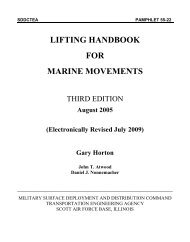Tiedown Handbook For Rail Movements - SDDCTEA - U.S. Army
Tiedown Handbook For Rail Movements - SDDCTEA - U.S. Army
Tiedown Handbook For Rail Movements - SDDCTEA - U.S. Army
Create successful ePaper yourself
Turn your PDF publications into a flip-book with our unique Google optimized e-Paper software.
SIXTH EDITION <strong>SDDCTEA</strong> PAMPHLET 55-19<br />
4. Securing Movable Structure<br />
Equipment with rotating parts, such as tank turrets, and movable parts, such as crane<br />
outriggers and booms, must have those parts positively secured, usually with wire rope.<br />
(rules 6.1 to 6.3) This prevents the parts from moving out or up during shipment. Serious<br />
accidents can result from parts striking bridges, structures, or passing trains.<br />
5. <strong>For</strong>ty-Five Degree <strong>Tiedown</strong> Angle<br />
Place the vehicles on the flatcar so the tiedown wire rope or chain makes<br />
approximately a 45 degree angle with the flatcar's deck when viewed from the side.<br />
Measuring by eye is usually good enough. If you want to layout the correct angle with a<br />
tape measure, make the longitudinal distance from the point the tiedown attaches to the<br />
deck to the tiedown provision on the vehicle equal to the vertical distance from the deck to<br />
the provision (Fig 2). Do not cross the tiedowns.<br />
6. Inverted <strong>Tiedown</strong>s<br />
Inverted tiedowns are tiedown chains or wire ropes that are secured under the<br />
vehicle rather than out, away from the vehicle (Fig 3). Inverted tiedowns are only<br />
appropriate in cases in which the tiedown does not contact any part of the vehicle except the<br />
tiedown provision. Do not use inverted tiedowns if the tiedown bears on the bottom of the<br />
bumper or frame of the vehicle. <strong>For</strong> example, some trailers do have tiedown provisions that<br />
are mounted below the frame such that inverted tiedowns can be used. Another<br />
consideration is the vehicle ground clearance. To use inverted tiedowns, there must be<br />
enough space under the vehicle for a soldier to adequately secure the tiedowns.<br />
7. <strong>Tiedown</strong> Provisions<br />
The procedures in this pamphlet generally cover equipment that was manufactured<br />
to meet MIL-STD-209, Interface Standard for Lifting and <strong>Tiedown</strong> Provisions. MIL-STD-<br />
209 provides for adequate strength tiedown provisions for all modes of transport including<br />
rail. Some equipment requires specialized procedures, which will be described on a MIL-<br />
STD-209 data plate attached to the equipment. MIL-STD-209 is available at:<br />
http://www.tea.army.mil/pubs/nr/deploy/transinstruction/MIL-STD-209K22feb05.pdf<br />
11




